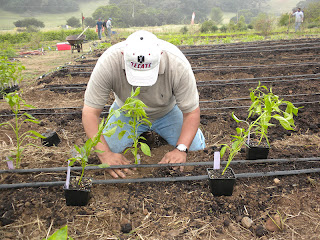Our last post was about the flurry of activity—a planting party
tansitioning from winter/early spring to a spring/summer garden.
As the title suggested, a lot happened that day with tractors going
and many hands furiously working to plant
150 tomatoes, 100 peppers and 100 eggplants.
But actually there is always a lot happening at the farm.
Sometimes it may not be as visible or obvious as when the tractor is rolling.
But there is always activity at the farm—whether it is a day
when just one or two of us are weeding and
tending to the beds,
or on those days
when no one is even there.
 |
| garlic bed photo by Cece Hugo |
At the biodynamic farm on Imagery Estate Winery vineyard,
our stalwart assistants, the "good bugs,"
are ever present doing their work all the time,
our stalwart assistants, the "good bugs,"
are ever present doing their work all the time,
when we can see them and often when we cannot.
The soldier beettle is aptly named as an important predator of aphids.
This little guy is" highly desired by gardeners as
So we are careful as we do our work
when we encounter a soldier beetle
to allow him to do his.
And we try to remember, and you should too, that while caterpillars
may be a nuisance for some plants, they do turn into
butterflies who enjoy the garden as much as we do, and bring us great pleasure.
 |
| photo: Matthew Ruff of Butterfly in sage plant at ESTATE |
Perhaps the hardest worker at the farm are the bees.
"Bee pollination of crops, something that most farmers heavily rely on,
is responsible for as much as 30% of the U.S. food supply."
Much has been written about this and the current crisis
of bees dying at unsustainable rates.
Bees are the premier pollinators of the world, and without them,
farmers worldwide would experience massive crop failures, especially for orchard fruits,
berries, cucumbers, squash, tomatoes, peppers and other bee-pollinated plants.
Bees are truly a farmer's and gardener's friend.
No question about the phrase, "busy bees!"
farmers worldwide would experience massive crop failures, especially for orchard fruits,
berries, cucumbers, squash, tomatoes, peppers and other bee-pollinated plants.
Bees are truly a farmer's and gardener's friend.
No question about the phrase, "busy bees!"
 |
| carefully peering into the lavender where the bees are hard at work |
The lavender bushes in the Insectary which attract the bees,
are close to our planting beds so they can support our work.
are close to our planting beds so they can support our work.
All of the plants in the Insectary surrounding the farm have been designed
to maintain a natural balance attracting the good bugs.
Our owl house ensures we will have a sentry to help control rodents.
Certainly the owl monitors all the "small moments" at the farm.
 |
| so much going on in these bushes at the Insectary |
And, truly every day there are small things happening
at the farm that are really big moments.
at the farm that are really big moments.
As one brave blossom appears and begins to grow,
we can feel the energy of the plant or tree as it begins to "breathe" and stretch out.
 |
| one of our first figs |
 |
| the apricot tree begins to bloom |
 |
| and pear blossoms in the Orchard |
 |
| strawberries starting to appear |
 |
| inspire this vanilla ris au lait with port-roasted strawberries |
The small things in the garden matter as much as the big major events.
And small gardens matter too.
We are proud of the farm and the orchard
but also appreciate how much we can grow around the restaurants.
And you can grow so much food at home as well.
Check out Verdura for tips on creating an edible garden, even in small spaces and
we really enjoy A Sonoma Garden for insight and inspiration.
And small gardens matter too.
We are proud of the farm and the orchard
but also appreciate how much we can grow around the restaurants.
 |
| this lemon tree right outside ESTATE's bar |
 |
| makes for a very fresh Lemon Drop (photo by Steven Krause) |
Check out Verdura for tips on creating an edible garden, even in small spaces and
we really enjoy A Sonoma Garden for insight and inspiration.
Let us know about the progress in your garden
and please share links that pique your interest in the gardening experience.































.JPG)






.JPG)






